by Jay
- 9 minute read - 1875 wordsThe header image for this post was created by DeviantArt user Annika-86, the original version is available here
Back in the very early 2000s I had a Dreamcast, and one day I was browsing the shelves at my local video game store and saw a title whose name jumped out at me: “Shadow Man”
This was in the UK, so it was a PAL Dreamcast jewel case - the whole blue background, white text on the side of a wide CD case.
As a side note, the PAL Dreamcast game packaging was a modified CD jewel case, being many times thicker than the standard jewel case and could hold up to four discs. And, according to Wikipedia, here’s why:
All cases of PAL region games for PlayStation and Dreamcast are thicker than standard North American and Japanese CD-cases. This is due to thicker manuals that often include many European languages. An exception to this were Australian-market PlayStation games later in the console’s life, which were released in standard-sized jewel cases with the manual in English only
source: https://en.wikipedia.org/wiki/Video_game_packaging#Console_packages
Anyway, I remember taking Shadow Man off of the shelf it was on, and turning it to look at the cover art.
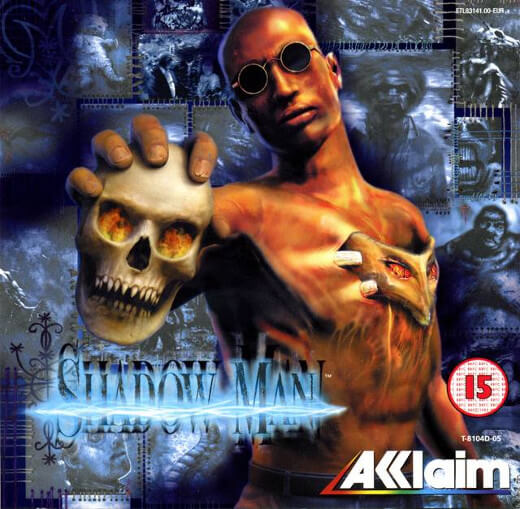
If that doesn’t grab you, I don’t know what will
I didn’t have a clue what this game was about, but I knew that I needed to play it. What’s that in the top right-hand corner? Why is there a teddy bear amongst all of these creepiness? What’s that on the guy’s chest?
A Polite Warning
Just a polite warning before we continue. For those who don’t know, that red 15 in a circle is a BBFC rating. In the UK there are two types of content ratings for video games:
- BBFC (British Board of Film Classification)
- PEGI (Pan European Game Information)
Until PEGI was created (in 2003), most video games in the UK either didn’t require a rating, or where rated by the BBFC. Between 2003 and 2012, both BBFC and PEGI ratings could be used (with BBFC ratings being required, if a game was certified as 15 or above) - during this time, PEGI was optional.
As of 2012, PEGI ratings are now legally enforceable for games rated 12 (BBFC ratings of 15 or 18 are still enforcable). Until 2012, the PEGI ratings where more of a suggestion than an enforceable rating (at least in the UK). It is a criminal offence for a retailer to knowingly sell a PEGI 12 or BBFC 15 or 18 rated video game to someone under age.
All of this is my way of saying that this game is incredibly dark, and has some pretty nasty themes to it. By today’s standards it’s a little tame, but it was terribly dark and quite disturbing in parts.
The area of the game called The Playrooms springs to mind
More on that in a moment, though
The Game
Shadow Man was an Nintendo 64 game developed by Acclaim Teeside (a UK subsidiary of now defunct Acclaim Entertainment) and published by Acclaim Entertainment in 1999. It was later ported to Windows, PlayStation, and Dreamcast in 1999 and to MacOS in 2013. It is based on a dark comic book series with the same name, which was published by Valiant Comics.
The Setting
I’m not going to go deep into the plot, but the short version is:
A shadowy man known as Legion has spent the past 200 years building a Cathedral to Pain in Deadside - “the place where everyone goes when they die. No exception” (to quote Michael LeRoi, the player character). He has done this by enlisting the help of five serial killers, including Jack the Ripper (who in the universe of the game, was an architect).
Michael LeRoi is the current heir to the title of Shadow Man. He has the ability to cross between the worlds of Liveside (the land of the living) and Deadside (the land of the dead). He is an immortal Voodoo warrior, who is tasked by the Bokor Mamma Nettie with stopping Legion from unlocking the power of the Dark Souls. If Legion is allowed to unlock the power of the Dark Souls, he will be able to bring his army of the damned over to Liveside, where they will be invulnerable and being about the end of days.
Design
Shadow Man is a non-linear game; meaning that you can (within limits) traverse around Liveside and Deadside in almost any order that you want. There is a logical path to the game and story, and taking that path is both the easiest and yields the most story details and dialogue.

The physical map included with the game shows all of the paths through Deadside
As Michael LeRoi is new to being the Shadow Man, we’re is encouraged to back track almost constantly in order to get more information from his confidants: Mamma Nettie and Jaunty.
The Characters
Which leads me, quite nicely, onto the characters.
The player takes control of Michael LeRoi. Michael lost his younger brother, Luke, to a drive by shooting and approached Mama Nettie as a way of dealing with the pain.
Mike is also the guy on the cover holding the skull
Mama Nettie, following the Prophecy of Shadows,
written by an earlier Shadow Man, and tells of Legion and the one who will destroy him
decides to make Michael the latest Shadow Man. Rather than give Michael the Mask of Shadows (in order to give him his powers), she decided to knit it into his rib cage. This gives Michael the powers of the Shadow Man, but only in Deadside
until Nettie performs a rite which brings a darkness onto the world, allowing Mike to have the powers of the Shadow Man in Liveside.
Michael uses Luke’s teddy bear to travel between Liveside and Deadside; he can do this because of the incredibly strong emotional connection between him and Luke. As soon as he steps into Deadside, Michael LeRoi becomes Shadow Man.
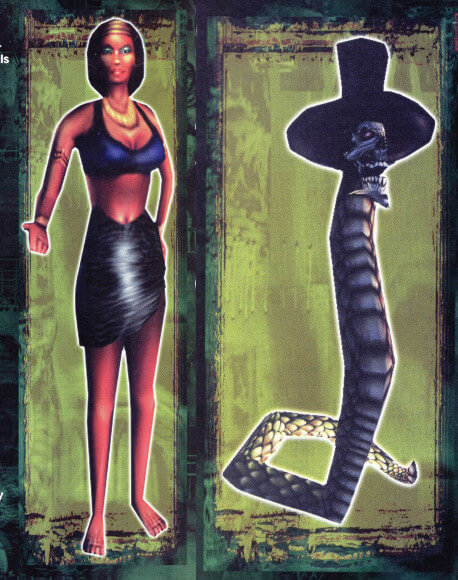
Nettie on the left, and Jaunty on the right
He is aided in Deadside by Jaunty. Jaunty is the keeper of the Gates of Shadow (which leads to the Paths of Shadow), is a giant snake with a human skull for a head, wears a top hat, and (when he was a live) was Irish.
Technically Mike/Shadow Man is immortal; this means that when you die, you’re transported back to the beginning of the area you are in.
with the exception of when you fight Legion
Deadside is populated with all sorts of nasty enemies who want to do nothing but tear Shadow Man apart. I’ll cover them in the section on Deadside.
There’s also the five serial killers and Legion to deal with. Each serial killer is accessed by finding their Schism in the Cathedral of Pain, and passing over to Liveside. Once found Mike/Shadow Man must kill each one, only then can he take on Legion
for we are many
and stop his plan of world damnation.
Liveside
Liveside is the land of the living. Not much of the early parts of the game take place here.
at least, not until Mamma Nettie performs some questionable acts and brings about a darkness, that is.
The game starts here, as Michael LeRoi is summoned from his home in New Orleans to Mamma Nettie’s church in the Bayou.
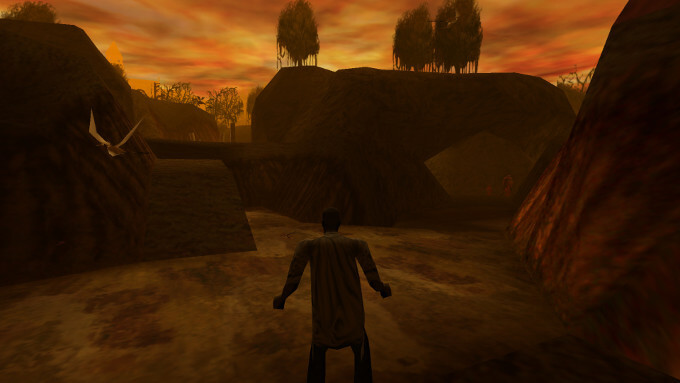
The Bayou is one of the lighter exteriors in the game. Which shows just how dark it is, at points
Looking past the initial “blockyness” of the game,
it was a title from 1999 and was originally designed to run on the N64, after all
there’s a lot on show in this game. From dynamic lighting
firing Shadow Man’s gun or unlocking the disco mode shows this off in all of it’s glory
to water effects (there are points in the game where Shadow Man must wade through and swim in pools of blood), incredible (for the time) drawing distances to large expansive areas (with almost no load time on the optical media based ports).
There are points in the game where there are multiple effects on screen at once - blood splattering everywhere, water effects, fire effects and multiple enemies - and there is very little to no slow down. There only seems to be stuttering when particle effects are used - these are mostly when Shadow Man is using some of his later powers to allow him to walk through fire without taking damage - an amazing feat, considering what’s on show here.
The locations in Liveside are pretty diverse, too. There’s the Bayou; an abandoned maze of tunnels in the London underground; a prison overrun with the dead; and an empty apartment building (which manages to combine the Bradbury Building from Blade Runner with the house from the original Texas Chainsaw Massacre).
Deadside
This is where most of the horror of Shadow Man happens. Deadside is, after all, where all of the dead go without exception.
The locations in Deadside seem to flit between extremely dark (especially in some of the Paths of Shadow)
as in, ‘I have to fire Shadow Man’s weapon or equip the Flambeau just to see’
to extremely well lit up (mostly the temples and the Cathedral).
Combine the darkness of the Paths of Shadow with the fact that Zombi’s tend to jump out at you and roar and snarl like a lion, and you’ve got plenty of organic jump scares.
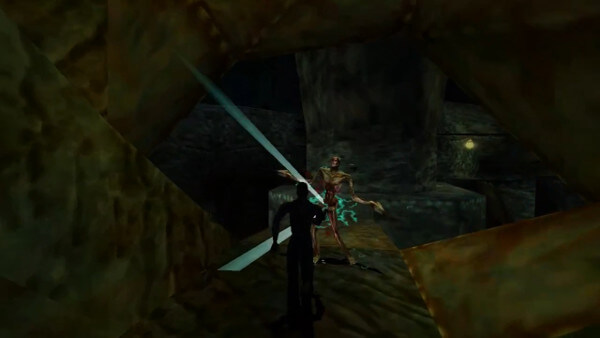
Here we’ve destroyed a Zombi (he’s about to explode and rain blood and gore down on us) after he jumped out from behind us, all screaming and seeking blood
Whereas the lighter areas of the Paths of Shadow have a completely different feel to them. They feel a little like a standard platformer of the time - similar to say Tomb Raider.
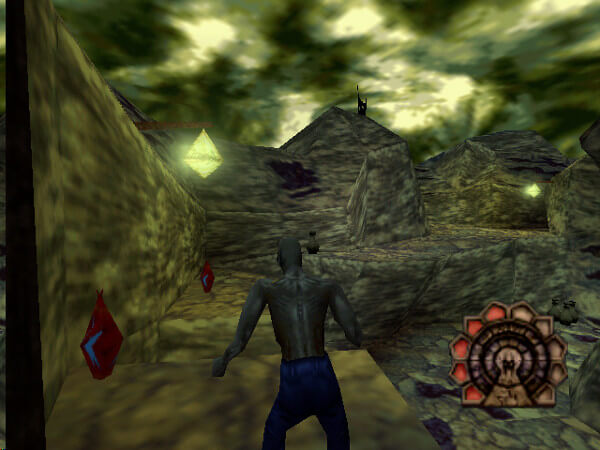
The stark contrast can sometimes through players off, but I suppose that’s the point. This game is meant to be unsettling
However, the single most disturbing and unsettling area in this game is the Playrooms.
The Playrooms is an area within the Cathedral which is used to create and raise the enemies known as “The Brutals”. Progression through this area (which includes birthing chambers, creche like childcare areas, and a massacre chamber where Deadsiders
the name given to those who have passed (i.e. you and me, when we die)
are torn to pieces by the Hookmen.
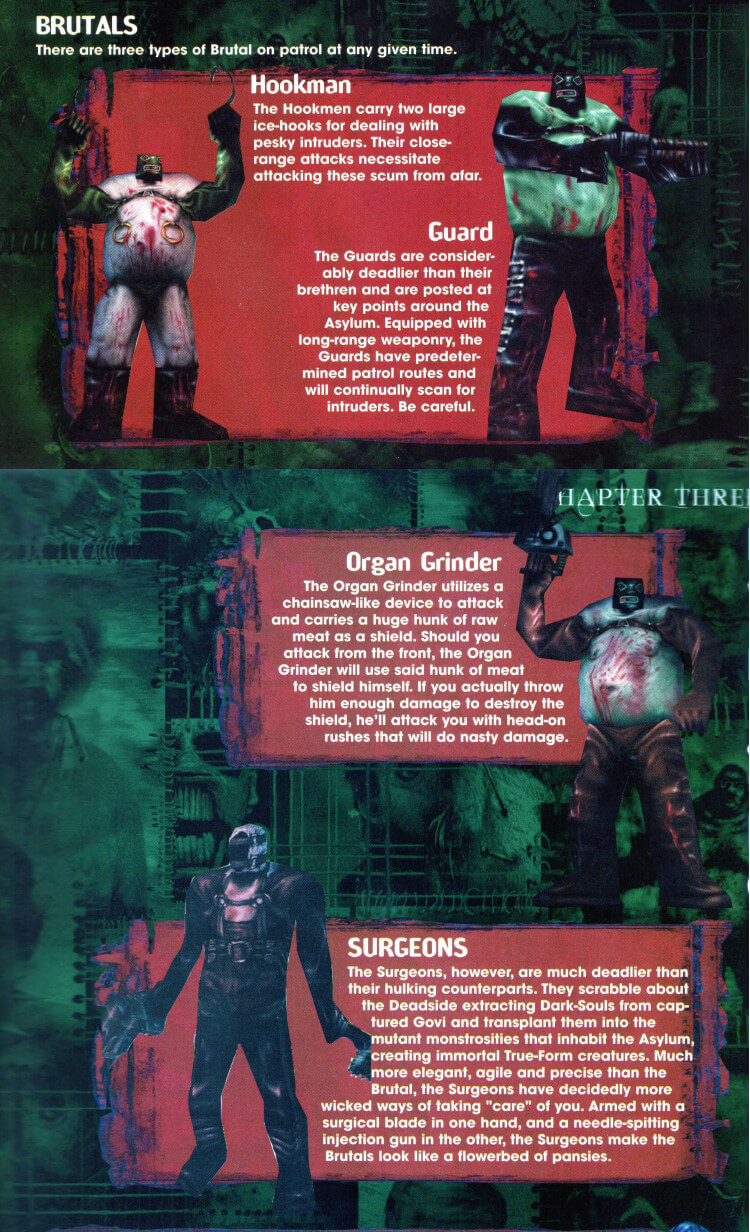
I’ll let the official strategy guide explain The Brutals, because it does a much better job that I can
As if the setting wasn’t unsettling enough, the entire time that you’re progressing through the Playrooms, you’re treated to a piece of music which includes the sounds of babies laughing, saws tearing flesh asunder, and euphoric laughter.
Seriously, it’s deeply unsettling. Here’s a short sample of it, so that you can get a taste for just how unsettling it is:
That’s from an official release by Tim Haywood himself, by the way
I think I’ll leave it there for now, having just creeped you out with the music from the Playrooms. I’ll finish I what I’ve started here, in the next part.
Until then,
I am Legion, for we are many